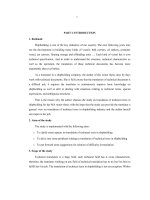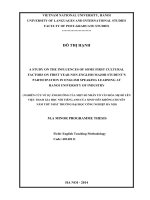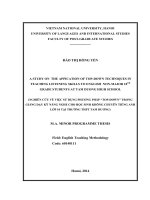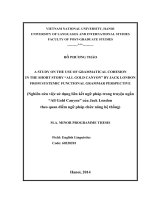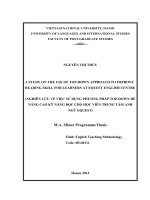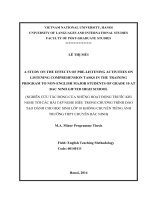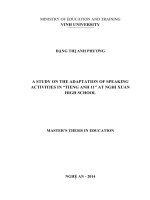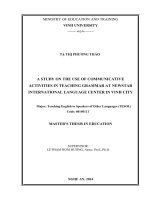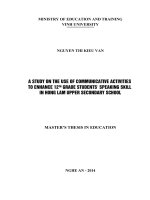Study on the protocol of micropropgation of gerbera sorbet
Bạn đang xem bản rút gọn của tài liệu. Xem và tải ngay bản đầy đủ của tài liệu tại đây (2 MB, 68 trang )
VIET NAM NATIONAL UNIVERSITY OF AGRICULTURE
FACULTY OF BIOTECHNOLOGY
GRADUATION THESIS
“STUDY ON THE PROTOCOL OF
MICROPROPAGATION OF GERBERA SORBET”
Hanoi, 2021
VIET NAM NATIONAL UNIVERSITY OF AGRICULTURE
FACULTY OF BIOTECHNOLOGY
GRADUATION THESIS
“STUDY ON THE PROTOCOL OF
MICROPROPAGATION OF GERBERA SORBET”
Student‟name
: Dam Thi Binh
Student‟s ID
: 610590
Class
: K61-CNSHE
Supervisors
: Nguyen Thanh Hai, Assoc. Prof.
Hanoi, 2021
ACKNOWLEDGEMENT
In facts there are no successes that are not associated with support or assistance,
whether more or less, directly or indirectly by others. This thesis consumed huge
amount of work, enthusiasm and dedication. Still, implementation would not have
been possible if I did not have a support of many individuals and organizations.
Therefore, I would like to extend our sincere gratitude to all of them.
First and foremost, I would like to express my deep and sincere gratitude to
Assoc. Prof. Nguyen Thanh Hai - Department of Plant Biotechnology of Vietnam
National University of Agriculture with his knowledge and dedication to convey
valuable knowledge to us during the time of studying at the school.
Secondly, many people, especially my friends have made valuable comment
suggestions on this thesis which gave me an inspiration to improve our assignment. I
thank all the people for their help directly and indirectly to complete my assignment.
Finally, I express my deepest thanks to my parents for their love, prayers,
caring and sacrifices for educating and preparing us for my future. I choose this
moment to acknowledge their contribution gratefully.
I perceive as this opportunity as a big milestone in my study development. I
will strive to use gained skills and knowledge in the best possible way, and I will
continue to work on my best, in order to attain desired future goals. Hope to continue
cooperation with all of you in the future.
Hanoi, 18th January 2021
Student
Dam Thi Binh
i
COMMITMENT
I assure that this study is my own research project under the scientific guidance
of Assoc. Prof. Nguyen Thanh Hai. The contents of the study, the results of this thesis
are honest and unpublished.
Hanoi, 18th January 2021
Student
Dam Thi Binh
ii
ABSTRACT
ACKNOWLEDGEMENT ................................................................................................ i
COMMITMENT ............................................................................................................. ii
ABSTRACT ................................................................................................................... iii
ABBREVIATION ........................................................................................................... v
LIST TABLE .................................................................................................................. vi
LIST FIG ....................................................................................................................... vii
PART I: INTRODUCTION ......................................................................................... 1
1.1. Preface ...................................................................................................................... 1
1.2 Purpose and requirements .......................................................................................... 1
1.2.1. Purpose .................................................................................................................. 1
1.2.2. Requirements ......................................................................................................... 2
PART II: LITERATURE REVIEW ............................................................................ 3
2.1. General introduction about Gerbera jamesonii Bolus .............................................. 3
2.1.1. Scientific classification .......................................................................................... 3
2.1.2. Morphology ........................................................................................................... 3
2.1.3 Ecological characteristics ....................................................................................... 4
2.2. Tissue culture of Gerbera ......................................................................................... 5
2.2.1. Concept of gerbera tissue culture .......................................................................... 5
2.2.2. Establishment of Gerbera jamesonii Bolus plantlets ............................................. 6
2.2.3. Establishment of Gerbera jamesonii Bolus in rooting media .............................. 20
2.2.4 Hardening medium ............................................................................................... 23
PART III: MATERIALS AND METHODS ............................................................. 26
3.1. Time and Location of the experiment .................................................................... 26
3.2. Experimental materials ........................................................................................... 26
3.2.1. Plant material ....................................................................................................... 26
3.2.2. Source of materials: ............................................................................................. 27
3.2.3. Culture media ...................................................................................................... 27
3.2.4. Hardening media.................................................................................................. 27
3.3. Experimental content .............................................................................................. 27
3.3.1. Establishment explants on culture ....................................................................... 27
iii
3.3.2. Determine effect of growth regulators on in vitro multiplication of Gerbera
Sorbet ...................................................................................................................... 28
3.3.3. Determine the appropriate rooting medium for the complete Gerbera Sorbet .... 29
3.3.4. Determine the suitable substrate to plant Gerbera Sorbet in greenhouse ............ 30
3.4. Experimental methods ............................................................................................ 30
3.4.1.Plant tissues culture .............................................................................................. 30
3.4.2 Subcultures ........................................................................................................... 30
3.4.3 Culture conditions................................................................................................. 30
3.5 The evaluation criteria ............................................................................................. 31
3.6. Data processing method ......................................................................................... 31
PART IV: RESULTS AND DISCUSSIONS ............................................................. 32
4.1. Establishment explants on culture .......................................................................... 32
4.1.1.The 1st experiment:Study the effect of sterilization time with 1 % Presept
solution on the budding rate of Gerbera Sorbet...................................................... 32
4.1.2. The 2nd experiment: Study the effect of the explants type on the budding rate
of Gerbera Sorbet.................................................................................................... 33
4.2. Determine effect of growth regulators on in vitro multiplication of Gerbera
Sorbet ...................................................................................................................... 34
4.2.1. The 3rd experiment: Effect of BA on the multiplication of Gerbera Sorbet
shoots ...................................................................................................................... 35
4.2.2. The 4th experiment: Effect of Kinetin on the multiplication of Gerbera
Sorbet shoots .......................................................................................................... 37
4.3. Determine the appropriate rooting medium for the complete Gerbera Sorbet ............. 38
4.3.1. The 5th experiment: Effect of IBA on rooting of Gerbera Sorbet shoots ........... 39
4.3.2. The 6th experiment: Effect of NAA on rooting of Gerbera Sorbet shoots ......... 40
4.4. Determine the suitable substrate to plant Gerbera Sorbet in greenhouse. ............. 42
PART V: CONCLUSIONS AND RECOMMENDATIONS ................................... 44
5.1. Conclusions ............................................................................................................ 44
5.2. Recommendations .................................................................................................. 44
REFERENCES .............................................................................................................. 45
APPENDICES ............................................................................................................... 55
iv
ABBREVIATION
BAP
6-Benzylaminopurine
IAA
3-Indoleacetic acid
IBA
α-Indole butyric acid
LSD
Least Significant Difference Test
MS
Murashige and Skoog medium
α-NAA
α-Naphthalene Acetic Acid
v
LIST TABLE
Table 3.1 the treatments of the first experiment ............................................................ 27
Table 4.1. Effect of sterilization time with 1 % Presept solution on the budding rate
of Gerbera Sorbet .......................................................................................... 33
Table 4.2. Time to morphology of the cultures ............................................................. 34
Table 4.3. Effect of BA on in vitro shoot proliferation gerbera sorbet after 4 weeks ... 35
Table 4.4. Effect of Kinetin on in vitro shoot proliferation gerbera sorbet after 4
weeks............................................................................................................. 37
Table 4.5. Effect of IBA on in vitro rooting Gerbera Sorbet after 2 weeks .................. 39
Table 4.6. Effect of NAA on in vitro rooting Gerbera Sorbet after 2 weeks ................ 40
Table 4.7. Effect of substrate used on growth of Sorbet gerbera seedlings .................. 42
vi
LIST FIG
Fig 3.1. A flower of Gerbera Sorbet .............................................................................. 26
Fig 3.2. From right to left: axillary bud- shoot mature- clove....................................... 28
Fig 4.1. Explants after 1 week ....................................................................................... 32
Figure2. Axillary buds after 5 days and 2 weeks .......................................................... 34
Fig 4.3. Effect of BA on in vitro shoot proliferation gerbera sorbet after 4 weeks ...... 36
Fig 4.4. Effect of Kinetin on in vitro shoot proliferation gerbera sorbet after 4
weeks............................................................................................................. 38
Fig 4. 5. Effect of IBA on in vitro rooting Gerbera Sorbet after 2 weeks ..................... 40
Fig 4. 6. Effect of NAA on in vitro rooting Gerbera Sorbet after 2 weeks ................... 41
Fig 4.7. Gerbera Sorbet acclimated seedlings on peatmoss + 10% perlite substrate at
greenhouse after 6 weeks .............................................................................. 43
vii
PART I: INTRODUCTION
1.1. Preface
Gerbera (Gerbera jamesonii Bolus), which is also known as Transvaal Daisy, is
an important cut flower both in the domestic and the international markets. The genus
Gerbera was named in the honor of a German naturalist, Traugott Gerber. The flowers
are of various colours suit very well in different floral arrangements. The cut blooms
also have a long vase life of about 7 to 8 days. Gerbera is ideal for beds, borders, pots
and rock gardens. Gerbera is one of the leading cut flowers and ranks fifth among the
top ten cutflowers of the world (Parthasarathy and Nagaraju, 1999).
Gerbera Sorbet is a new flower variety introduced to Vietnam recently. It is a
variety with large flowers (10-12cm), bi-color (white & red) with black centre. The cut
blooms also have a long vase life of about 16-18 days. Gerbera Sorbet has great
potential for growing potted or cut flowers. Therefore, the seedling demand of this
variety is very much in present.
Gerbera is generally propagated by division of suckers or clump. Propagation
by division of suckers or clumps gives true to type plants, but the multiplication rate is
very low. It is not only costly; sometimes plants are of low quality. Farmers multiply
the plants by dividing clumps every year, which is result poor quality flower. It causes
loss in commercial business. Tissue culture finds its tremendous application in
ornamental crops, especially in areas of propagation and crop improvement. Plant
propagation either through meristem or non-meristem culture enables production of
large number of plants within a short span of time in limited space. Therefore, Study
on micropropagation of Gerbera Sorbet is necessary to meet the seedling demand of
this Gerbera Sorbet.
1.2 Purpose and requirements
1.2.1. Purpose
This study aims to complete the protocol of micro-propagation of Gerbera
Sorbet
1
1.2.2. Requirements
•
Determine effect of growth regulators on in vitro multiplication of Gerbera
Sorbet
•
Determine the appropriate rooting medium for the complete Gerbera Sorbet
•
Determine the suitable substrate to plant Gerbera Sorbet in greenhouse
2
PART II: LITERATURE REVIEW
2.1. General introduction about Gerbera jamesonii Bolus
Gerbera jamesonii, better known by its popular name, gerbera, belongs to the
Asteraceae (Compositae). The genus was named Gerbera after a German naturalist,
Traugott Gerber although it was the Scottsman Robert Jameson who discovered the
species in about 1880 near Barberton in the former Transvaal, in South Africa. At that
time, he donated the plant to the Durban Botanical Garden where John Medley Wood,
the curator there, sent the plant to Harry Bolus for identification of the species. Harry
Bolus then sent the species to the Royal Botanic Gardens in Kew, UK, suggesting the
scientific name as G. jamesonii. As the first official description of the species was
made by J. D. Hooker and published in 1889 by Curtis Botanical Magazine, it became
officially registered thereafter as G. jamesonii Bolus ex. Hook f.
2.1.1. Scientific classification
Science name
Gerbera jamesonii Bolus ex. Hook f.
Kingdom
Plantae
Phylum
Magnoliopsida
Class
Magnoliopsida
Order
Asterales
Family
Asteraceae
Genus
Gerbera
2.1.2. Morphology
The leaves do not have stipules and may be arranged opposite or alternate with
margins that are entire to deeply lobed. The texture may be leathery or succulent and
may be reduced to spins or needles.
The simple flower is in a tight inflorescence with many florets that sit on a
fleshy receptacle that is surrounded by many involucral bracts. In some genera the
bracts are reduced or not present and the receptacle may be in an elongated form
giving it a club-shape inflorescence.
3
Each flower has an inferior ovary normally with a colourful corolla on top with
the calyx reduced to scales, bristle or hairs around the corolla.
Three distinctive Floret Types
Disk florets are funnelform corolla tube that has five equal lobes with fertile
stamens and ovary.
The ligulate florets with a corolla that is split down one side and the limb
formed is extended to form showy ray florets. These flowers are unisexual.
The filiform florets come from disk florets when the corolla tube is a slim
cylindrical shape and these are normally unisexual.
The fruit produced from the different types is normally a cypsela (type of
achene) although some florets don't produce fruit.
The corolla has five petals, which are five lobes in disk florets but are not easily
seen in other types.
The stamens are arranged alternate with the petals and the filaments are
normally fused to the corolla tube with the anthers arranged around the style in a
connate form.
When the pollen falls onto the closed stigma the style elongates above the
stamens and then the stigma opens to be pollinated.
The ovary is inferior with one chamber and one ovule and forms a one seeded
fruit, which is really an indehiscent fruit (cypsela). These are normally distributed by
animals with barbs formed by the pappus and some by wind.
2.1.3 Ecological characteristics
Temperature: is one of the important factors determining the growth,
development of flowers and flower quality of Dong Dong. Most of Dong Dong flower
varieties today prefer a cool climate (15 - 25oC), but some varieties tolerate high
temperatures (30 - 34oC). In general, during the flowering period, it is necessary to
ensure the right temperature (for each Gerbera variety), the flowers will be big and
beautiful.
Light: is essential for the growth and development of plants. Light provides the
energy for photosynthesis and produces organic matter for plants. Photosynthesis
4
depends on the spectral composition of the light and the intensity of the light. The
intensity of plant photosynthesis increases with increasing light intensity and light
quality. But when the light intensity exceeded the critical level, the intensity of
photosynthesis began to decrease. Therefore, the use of black mesh is very effective to
reduce the light intensity in the hot season.
Humidity: Money is a shallow plant that cannot withstand waterlogging, but at
the same time has large biomass, large leaves, large water navigator, so less resistant
to drought. Soil humidity is 60-70%, the air humidity is 55 - 65%, favorable for the
growth of money. Especially at the time of harvest, moderate humidity is required.
During growth, to provide enough water for Dong Dong by drip irrigation and
pumping water to irrigate the plants.
Soil: The coin is suitable for fresh, spongy soil, with a pH of 6 - 6.5. In alkaline
soils that require acidic fertilizers for rehabilitation, sulfur fertilizers can also be
applied to reduce pH. In acidic soils, it is possible to supplement with lime to regulate
acidity, in heavy soil, add rotting leaves, rice husks, and wine residue to increase
porosity.
2.2. Tissue culture of Gerbera
The present experiment was conducted to find out the best explant, growth
regulators and hardening medium for in vitro multiplication of gerbera. Some of
important and informative works have so far been done in home and abroad related to
this experimentation have been presented (Year wise) in this part. The relevant
literature about these aspects have been reviewed and presented below.
2.2.1. Concept of gerbera tissue culture
Seed propagation in gerbera is not always satisfactory since impurity of strain
produces a great deal of variations (Schiva 1975). Moreover, traditional seed production
technique is too slow for their exploitation in commercial purposes (Murashige et al.
1974). It also requires longer time to produce flower. Vegetative propagation overcomes
the problem of unpredictable characters and plants obtained by this method perform better
than those developed from seeds. In vitro techniques of propagation have been recognized
as the preferred method for multiplication of selected elite clones (Reynoird et al. 1993,
5
Aswath and Choudhary 2002, Xi and Shi 2003, Prasanth and Sekar 2004, Kumar et al.
2004, Chakrabarty and Datta 2007 and ). A survey of literature
indicates that tissue culture of Gerbera has been studied by various scientists using
different types of explants (Barbosa et al. 1994, Parthasarathy et al. 1997, Le et al. 1999,
Posada et al. 1999, Zhang et al. 2002, Modh et al. 2002, Tyagi and Kothari 2004, Aswath
and Wanzeen 2004, Thakur et al. 2004, Kumar and Kanwar 2005, 2006, Sharma and
Srivastava 2005 and Ray et al. 2005).
Murashige et al. (1974) showed that gerbera can be propagated vegetatively by
shoot tip culture. A comparison of the two propagation methods, shoot tip culture and
capitulum explant culture showed that each method has advantages and disadvantages.
They reported that shoot tip system is much more rapid, but the initial number of shoot
tips required is very high due to the high infection rate (80%) and in turn require a
great number of mother plants. In case of capitulum explants, the number of shoots per
flower was much smaller, but loss by infection was only 10 percent. The use of
capitulum explants had the advantage of leaving the mother plant intact. They
proposed that for practical purposes both methods can be used, but the capitulum
system in the initial phase and shoot tip system in the later phase are better for mass
propagation.
2.2.2. Establishment of Gerbera jamesonii Bolus plantlets
The success of plant tissue culture as a means of plant propagation depends on
multiplication and establishment of plantlets which in turn are greatly influenced by
number of factors.
2.2.2.1 Explant
The type of explant, its size, position, age, physiological state and the manner in
which it is cultured can all determine, whether the cultures could be successfully
maintained and the morphogenesis could be induced. Shoot tip, bud, flower, leaf,
peduncle, petiole are the commonly used explants for in vitro gerbera multiplication.
Leffring (1971) concluded that the most efficient in vitro method for the
vegetative propagation of Gerbera jamesonii was by rhizome cuttings. Dormant buds
on excised rhizome can be forced to form shoots which can root. This method was
6
rather slow, particularly for plant breeders, as an average of only 20 plants could be
produced per year from a single plant.
Pierik and Segers (1973) reported that when inflorescence was cut into six
instead of four explants, the total number of shoots per flower was the same, but it
decreased when the inflorescence was cut into eight, ten or twelve explants. A slightly
higher number of shoots per explant was obtained from the inflorescence collected in
the month of June and July compared to those in other months. They concluded that
there was a very small probability that these shoots were of adventitious origin. They
insisted that shoot primordia in a quiescent state existed in the axils of the involucral
bracts. Murashige et al. (1974) showed that Gerbera can be propagated vegetatively by
shoot tip culture. A comparison of the two propagation methods, shoot tip culture and
capitulum explant culture showed that each method has advantages and disadvantages.
They reported that shoot tip system is much more rapid, but the initial number
of shoot tips required is very high due to the high infection rate (80%) and in turn
require a great number of mother plants. In case of capitulum explants, the number of
shoots per flower was much smaller, but loss by infection was only 10 per cent. The
use of capitulum explants had the advantage of leaving the mother plant intact. They
proposed that for practical purposes both methods can be used, but the capitulum
system in the initial phase and shoot tip system in the later phase are better for mass
propagation. Pierik et al. (1975) propagated Gerbera using fully developed
inflorescence. They found no differences in shoot formation between wide open and
older flowers. However, they found closed flowers and very young flowers were
inferior and had more infection than other flowers. Gregorini et al. (1976) opined that
in vitro culture of vegetative apices was a valid method for clonal multiplication of
Gerbera while, Pierik et al. (1979) reported that shoot tips are more suitable for mass
propagation than capitulum. Shoot formation from leaves was noticed during in vitro
propagation of Gerbera cultivar „Vulkan‟ (Hedtrich, 1979).
Mother plants with leaves removed were planted in green houses and tissues
taken from the new shoots or the rhizomes were grown on nutrient base for
propagation of gerbera through shoot tip culture (Raalte-D-Van, 1978).
7
Huang and Chu (1985) cultured ex vitro derived shoot tips of cultivars
„Arendsoog‟ and „Super Giant Yellow‟ and observed that ten shoots developed per
explant after four weeks of culture. Schum and Busold (1985) observed in vitro shoot
production to be higher and quicker from one to two cm long, flower bud explants.
They further noticed that shoot development in the axils of involucral bracts was most
common in buds, while shoots from undifferentiated callus occurred more frequently
in fully developed inflorescence.
The culture of portions of young capitulum at the bud stage of inflorescence
was proved more productive than that using fully developed inflorescence (Laliberte et
al., 1985). They used immature inflorescence of 0.5 to 0.7 cm in diameter and after
sterilization, involucral bracts were removed. The hypothesis of Pierik and Segers
(1973) and Pierik et al. (1975), that the dormancy of pre-existing buds in the axils of
the involucral bracts could be broken in the culture conditions, but this was excluded
by Laliberte et al. (1985), since involucral bracts had been removed from the explants.
According to them the buds resulted from the reorientation of meristematic tissues in
the explant. Kafarski and Hauzinska (1974) also used young capitulum as explants for
the multiplication of Gerbera jamesonii.
Arello et al. (1991) used capitulum explants to produce a large translucent
callus. Sitbon (1981), Meynet and Sibi (1984), Ahim and Vieth (1986) and Tosca et al.
(1990) showed the feasibility of producing haploid plants through in vitro ovule
culture. Adventitious shoot formation from leaf explants occurred at the base of leaf
petiole (Jezry and Lubomskii, 1991). Leaf, petiole and apex as explants of Gerbera
were used to establish tissue and cell cultures by Ruffoni and Massabo (1991). Leaf
explants produced numerous roots and apex explants produced more shoots and calli.
Effect of the age of plant material on in vitro regeneration was tested in
Dianthus caryophyllus by Altorst et al. (1992). The leaves of different ages (3, 5, 8, 10
and 12 weeks after subculture of donor cuttings) were taken from donor plants and
explants were examined for regeneration. The youngest leaves gave the best
regeneration results with seven shoots per regenerated explant. Regeneration
percentage decreased with increase in the age of leaf.
8
Efficient bud regeneration was obtained from leaf explants of a clone of
Gerbera hybrida cultured on modified MS medium. Morphogenic potential varied with
the development stage of the leaves. Up to 90 percent of excised developing leaves
formed three to five shoots per plant. Bud regeneration was not obtained on same
medium with fully expanded leaves (Reynoird et al., 1993). They noticed the effect of
developmental stage of leaf on morphogenic potential in clones 10 and 11 of Gerbera
hybrida. Further, they observed that younger leaves located in the centre of the rosette
were quite difficult to excise, but displayed the greatest ability to regenerate. The
regeneration capacities progressively decreased with the stage of leaf development and
fully expanded leaves were non-regenerative. A similar observation was made by
Orlikowska et al. (1995) where, the production of adventitious shoots was best from
the young leaf explants compared to the explants from petiole bases of old leaves.
Sreelatha et al. (1998) compared the effect of basal and apical portions of leaf
explants on callus initiation in Anthurium species. They noticed that callus initiation
was better in the basal portions of leaf explants. The difference in response between
the basal and apical portions was attributed to the difference in the physiological state
as well as the number of cells undergoing dedifferentiation. Physiological changes
may account for the changes in the contents of endogenous hormones, nutrients and
metabolites.
Gerbera plants were regenerated and propagated in vitro from floral peduncle
explants by Le-CL et al. (1999). De novo regeneration of adventitious buds was
possible by cutting peduncle tissues on a basal salt Murashige and Skoog medium,
which led to the production of axillary buds at the rate of 10 newly, formed shoots per
initial explant and per subculture.
Zhao et al. (2002) reported that the contamination rate could be lowered greatly
if the receptacle was used as explant for Gerbera. Maximum per cent contamination
was observed in shoot tip and flower (fully developed) explants.
Modh et al. (2002) successfully used young capitulum having a diameter of 0.5 to
1.0 cm as an explant from Gerbera cultivar „Atella‟ plants for in vitro culturing. Shailaja
(2002) studied the suitable explant for multiplication of Gerbera at Department of
9
Horticulture, UAS, Dharwad and found bud and flower as suitable explants for the
establishment of in vitro Gerbera culture.
The shoot tips of 0.5 - 1.0 cm length and leaf discs and petiole of 1 - 2 cm length
were used as explants for in vitro culturing by Mohanty et al. (2005). The shoot tip was
widely used as explant for Gerbera tissue culture studies by many workers (Murashige et
al., 1974; Gregorini et al., 1976; Raalte-D-Van, 1978; Petru and Matous, 1984; Huang and
Chu, 1985; Parthasarathy and Nagaraju, 1995).
The technique of using immature flower buds (1 - 1.5 cm long) as explants was
followed in carnation by Karami et al. (2007). Tui et al. (2005) also used young
capitulum as explants for in vitro regeneration of Gerbera jamesonii.
2.2.2.2. Surface sterilization of explants
Sterilization of explants is an essential requirement in order to improve the
success of micropropagation.
Gerbera plants of cultivars „Arendsoog‟ and „Super Gaint Yellow‟ were
stripped of roots and divided into portions from each of which all but the last
unexpanded leaf, were removed. The periderm of the rhizome was peeled off and the
shoots were sterilized in 1% NaOCl (sodium hypochlorite) solution for 10 minutes,
rinsed three times with sterilized water and reduced to 2 - 3 mm explants (Huang and
Chu, 1985).
Immature inflorescences, 0.5 to 0.7 cm in diameter of Gerbera jamesonii
cultivars „Pastourelle‟ and „Mardi Gras‟ were collected and sterilized for 2 minutes in
70 percent ethanol, for 9 minutes in sodium hypochlorite (1.5%) with Tween-20
(0.01%), and washed in sterilized distilled water for 45 minutes. After sterilization,
involucral bracts were removed, and the capitula were cut into 20 to 25 pieces. Each
explant, containing 25 to 40 sessile flowers was inoculated separately on solid medium
(Pierik et al., 1975; Laliberte et al., 1985).
Pre-treatment of mother plants by Ruffoni et al. (1987) comprised of
defoliation, a short immersion in a solution containing 100 g/1 Streptomycin + 1 g/1
Benlate + 1 g/1 Ridomil and transplanting into sterile 1:1 (peat : perlite) in sterile pots.
The best among the six explant treatments was provided sequential treatment with 3%
10
NaOCl for 20 minutes, 70% ethanol for 30 minutes followed by two changes of sterile
water for 10 minutes each.
Capitula collected at the moment of the expansion of ray florets, were surface
disinfected in 2 per cent sodium hypochlorite for 10 minutes and then rinsed three times
in sterile water (Tosca et al., 1990). Terminal buds of Chrysanthemum morifolium cv.
„Pennine Reel‟ were excised from vigorously growing shoots and immersed for 20
minutes in a solution of sodium hypochlorite containing 1.0-1.5 per cent (v/v) available
chlorine. Buds were immersed in two changes of sterile distilled water, each for 20
minutes and inoculated onto multiplication medium (Roberts and Smith, 1990). Capitula
(1 - 3 per genotype and 0.7 - 1.0 cm diameter) were collected from August to November
and sterilized in commercial bleach (2% sodium hypochlorite) for 30 minutes and then
rinsed in sterile distilled water (Conti et al., 1991).
Shoot tip explants were obtained from axillary shoots of greenhouse grown
plants of Gerbera jamesonii Bolus. A few outer leaves were removed, the blades of the
remaining leaves were cut off and the shoots were rinsed free of soil in autoclave
sterilized water. Subsequently, the shoots were disinfected for 20 minutes in
commercial bleach solution (1.3% NaOCl) containing 0.1 per cent Tween-20, and
rinsed in disinfectant solution with autoclave sterilized water. These explants of about
1 - 3 mm in length were transferred to nutrient medium, one explant per culture tube
(Jerzy and Lubomski, 1991).
The shoot tips of carnation were washed under running tap water for 1 - 1 ½
hours and dipped in 70 per cent alcohol for 45 seconds, they were then disinfected
with 0.2 per cent HgCl2 along with two drops of Tween-20 for ten minutes and
thoroughly rinsed with sterile distilled water for 3 - 4 times (Jagannatha, 1997). Shoot
tips, nodes and flower buds of carnation were immersed in a solution of carbendazim
(0.1%) each for 3 minutes and then washed thoroughly thrice with distilled water, then
they were immersed in 0.1 per cent HgCl2 for 3 minutes and washed with sterile
distilled water for 3 - 4 times in the laminar air flow cabinet (Hiremath, 2000).
The ray florets and young leaves of chrysanthemum were surface sterilized with
0.1 per cent sodium hypochlorite and then rinsed 4 to 5 times with sterile distilled
11
water (Tanaka et al., 2000). Explants from young capitula of Gerbera were surface
sterilized in 70 per cent ethanol for 25 - 30 seconds, followed by 0.1 per cent HgCl2
solution for 5 minutes (Modh et al., 2002).
Solutions of carbendazim (0.1%) and streptomycin (0.1%) each for 3 minutes
were used for immersion of explants, which were later washed thoroughly thrice with
distilled water and were again immersed in 0.1 percent HgCl2 for 3 minutes before
finally washing with sterile distilled water for 3 - 4 times in the laminar air flow
cabinet (Shailaja, 2002).
The explants size of 5 mm x 5 mm cut transversely to the midrib from mature
leaves were washed thoroughly with water for 5 minutes, disinfected with 70 percent
ethanol for 30 seconds and surface sterilized with filtered sodium hypochlorite (0.1%).
After 10 minutes, they were rinsed five times with sterilized distilled water, blotted on
sterile filter paper and 15 explants were plated with adoxial surface in contact with the
medium (25 ml) in 100 mm petri dishes (Aswath and Choudhary, 2002b).
Inflorescences were detached at developmental stage 2 for in vitro culture. They
were sterilized with 1% NaOCl for 10 minutes and rinsed with sterile distilled water
for three times. They were then incubated on the medium (8 g/1 agar with 3% sucrose)
under 14 hours light/10 hours dark cycles at 23 - 25ºC (Meng and Wang, 2004).
Mohanty et al. (2005) treated the segments of mature and immature leaves as
well as petioles with Bavistin (0.2%) for 30 minutes and washed under running tap
water. The explants were washed with Teepol for 10 minutes followed by tap water.
Then they were treated with 0.1 per cent HgCl2 solution for different durations under
laminar air flow cabinet. Further they were dipped in 1 percent KCl solution for one
minute to remove toxic Hg2+ ions from the surface of the explants. The sterilized
explants were cut with a scalpel and surgical blade and washed thrice with autoclaved
distilled water before inoculation.
Ranjan and Gaurav (2005) in their experiment took leaf segments and pieces of
petiole of 1 - 2 cm size as explants. They were washed under running tap water for 15
minutes and treated with carbendazim (0.2%) for 30 minutes and surface sterilized
with HgCl2 (0.1%) for 10 minutes, followed by washing 3 - 4 times by sterile distilled
12
water. Mature explants were collected from greenhouse-grown plants and washed
thoroughly with tap water followed by distilled water containing a few drops of
Teepol. The explants were dipped in 10% calcium hypochlorite solution for 5 minutes,
followed by a dipping in 0.1% HgCl2 solution for 10 minutes. Again they were rinsed
with sterile distilled water for 4 - 5 times and blotted on a sterile tissue paper (Negi et
al., 2006).
Nhut et al. (2007) reported that receptacles (1.5 - 2.0 cm in diameter) of 10
interspecific crosses of young Gerbera flowers (7 - 14 days old) were washed
thoroughly under tap water for 20 minutes, soaked in My Hao detergent (Vietnam) for
15 minutes, then washed thoroughly under tap water again for 2 hours, rinsed six times
with distilled water and then submerged in a 7% (w/v) solution of Ca(ClO2) for 25
minutes followed by rinsing six times in sterile distilled water in the laminar air flow
cabinet.
2.2.2.3. Culture media
The success of plant tissue culture is greatly influenced by the nature of the
culture medium used. Plant tissue culture media provides major and minor nutrient
elements and carbohydrates. A wide variety of media have been reported. The choice
depends on the plant species and the intended use of the culture.
Murashige and Skoog (1962) medium characterized by high concentration of
mineral salts has been widely used for general plant tissue culture. No other factor has
received as much attention as media, since the success in plant cell culture is largely
determined by the quality of nutrient media (Vasil and Thorpe, 1994).
Improved results were obtained by providing trace amounts of organic
compounds notably vitamins and amino acids (George and Sherrington, 1984). A
nutrient media comprising of MS macro elements at half strength, Heller‟s micro
elements, Na2Fe-EDTA at 21.4 mg/1, MS organic constituents and 10 g/1sucrose with
pH adjusted to 5.6 was used for excised scape culture (Huang and Chu, 1983).
Growth and morphogenesis in in vitro are regulated by the interaction and
balance between the growth regulators supplied in the medium and the growth
substances produced endogenously by the cultured cells. Apart from the direct effect
13
on cellular mechanisms, many synthetic growth regulators may in fact modify the
level of endogenous growth substances (George and Sherrington, 1984).
Schum and Bichler (1986) cultured Gerbera cultivars „Hildegard‟ and „Th-102‟
in ten different media and then potted in a greenhouse. Subsequent growth was best in
plants cultured on media of Pierik et al. (1975) and poorest on that of Murashige et al.
(1974), which had the highest salt concentration of macro elements.
Villalobos (1986) reported that when carnation apical meristems with 2 leaf
primordia were cultured on various concentrations of MS salts (100, 75, 50 or 25 per
cent), explant growth and differentiation were best at the full strength or the highest
concentration.
Shoots of Gerbera cultivars „Clementine‟, „Saskia‟ and „Terravisa‟ were
multiplied on media without or with the addition of thiamin, pyridoxine, nicotinic acid,
myoinositol, tyrosine and adenine sulphate, in the original strength or in concentration
reduced to one-half or one quarter. In three subsequent passages, the multiplication
rate of the shoots did not depend on the concentration of thiamin, pyridoxine, myoinositol and adenine sulphate (Soczek and Hempel, 1988).
Tosca et al. (1990) reported that naked mature unfertilized ovules, collected
from April to October, were cultured successfully on modified MS basal medium plus
0.88 µM BA (6-benzyl adenine) and 0.57 µM IAA (3-indole acetic acid). Culture
initiation using shoot tip explants was carried out on medium containing MS salts, 100
mg/1myo-inositol, 0.4 mg/1thiamine-HCl, 10 g/1sucrose, 8 g/1Bacto agar with the
addition of 0.5 mg/1IAA (Jerzy and Lubomskii, 1991).
Shoots were regenerated on Murashige and Skoog's (1962) basal medium (3%
sucrose, 0.8% Difco Bacto agar) supplemented with three concentrations (0.5, 1, 2
mg/1) of 6-benzyl amino purine (BAP) in combination with four concentrations (0.2,
0.5, 1, 2 mg/1) of α-naphthalene acetic acid (NAA) (Chin-Yi et al., 1990). MS media
with 3 mg/1BA, 0.5 mg/1IBA, 100 mg mg/1 myo-inositol, 0.4 mg/1thiamine-HCl, 10
g l-1 sucrose and 8 g/1Bacto agar was used for regeneration studies using in vitro
derived leaf explants of Gerbera (Jerzy and Lubomskii, 1992).
14
Barbosa et al. (1993) cultured three-leaf bud explants of Gerbera cultivar
“Applebloesen” on MS medium supplemented with 3 percent sucrose, 80 mg adenine
sulfate, 100 mg tyrosine, 7 g Difco Bacto agar and growth regulators.
The initial explants of three to four of the youngest leaves with petioles in
Gerbera, were obtained from 3-week-old shoot cultures multiplying on a medium
comprised of modified MS mineral salts with the addition of 85 mg/1NaH2PO4 and
vitamins, 9.3 µM kinetin, 0.6 µM 3-indole acetic acid, 20 mg l -1 adenine sulfate, 20
g/1sucrose and 7 g/1Bacto agar (Orlikowska et al., 1999).
Topoonyanont et al. (1999) reported that Gerbera jamesonii cultivars
„Rosabella‟ (bushy) and „Sunset‟ (normal or non-bushy) were multiplied in vitro on a
basal medium containing Murashige and Skoog (1962) macro elements, 40 mg l-1
NaFeEDTA, 100 mg l-1 myo-inositol, 40 g l-1 sucrose, 8 g l-1 BDH agar, 0.86 mg l-1
kinetin and 0.5 mg l-1 IAA.
The effect of MS, half MS, one-fourth MS and one-eight MS medium in
Gerbera was evaluated by Aswath and Choudhary (2002). The number of shoots was
highest on half MS medium and lowest in one-eighth medium. This result was similar
to that of Huang and Chu (1985). Shoot proliferation from leaf segment of Gerbera
was found to be the best on half MS medium and poor when diluted further. However,
Jerzy and Lubomskii (1991) reported that half or full strength MS salts did not
influence the adventitious shoot formation from petioles.
Modh et al. (2002) used MS medium supplemented with various levels of BAP
(1.0 to 10.0 mgl -1 ) and IAA (0.1 mg l-1 ) for culturing the explants cut from capitula,
whereas Ranjan and Gaurav (2005) used the modified Murashige and Skoog medium
supplemented with various combinations and concentrations of plant growth regulators
such as IAA, IBA, NAA, 2,4-D, kinetin and BAP with sucrose (3%) and agar (0.8%).
Mohanty et al. (2005) concluded that MS medium supplemented with BAP (1
ppm) was the best for in vitro proliferation of Gerbera cultivar „Alsmeera‟ from shoot
tip explants. Maximum callus induction was achieved through amendment of 2,4-D (5
ppm) on MS medium from leaf disc during summer season, keeping in diffused light
condition.
15
2.2.2.4. Growth regulator
Hasbullah et al. (2008) also reported that addition of auxins along with
cytokinins was essential for shoot induction in gerbera. When BAP was supplemented
with IAA callus was induced but no shoot proliferated. On the other hand when BAP
was supplemented with NAA, in some combinations callus induction as well as shoot
proliferation occurred. Pierik et al. (1973) also reported that addition of strong auxin
(NAA) with BAP promoted better shoot formation compared to weak auxin (IAA).
Chakrabarty and Datta (2008) obtained best shoot multiplication on MS
containing only BAP, Kn and TDZ. Kanwar and Kumar (2006) also reported that IBA
was the best medium for root induction in Gerbera.
Murashige et al. (1974) rapidly multiplied shoot tips and a satisfactory rate of
increase in divisions was obtained by simply lowering the IAA level and in the basal
medium. Favorable effect of cytokinins (especially zeatin riboside) on formation of
new buds on vegetative apices was noticed by Gregorini et al. (1976)
Pierik et al. (1975) reported that no shoots developed from excised capitulum
explants on cytokinin free media. The addition of BA or BAP in higher concentration
was very essential, the optimum being 10 and 5 mg l-1 respectively. BAP was found to
be slightly more effective than BA. They felt auxin was not essential for shoot
formation, although the addition of a low auxin concentration (IAA at 0.1 mg l-1 or
IBA at 0.05 mg l-1 ) was slightly more stimulative in comparison to no auxin. Shoots
were successfully regenerated from excised scape explants on MS medium
supplemented with 10 mg l-1 BA (Huang and Chu, 1983).
The regeneration of adventitious shoots from leaf blades was observed by
Hedtrich (1979) during his study on Gerbera jamesonii cultivar „Vulkan‟ on modified
Murashige and Skoog medium supplemented with 1 mg l-1 BAP and 0.1 mg l-1
gibberellic acid.
Petru and Matous (1984) propagated shoot tips of cultivar „Lada‟ on MS medium
containing 7 mg l-1 kinetin and 0.2 mg l-1 IAA. The shoot tips were successfully cultured
on a medium containing 5 mg l-1 BA and 0.1 mg l-1 IAA (Huang and Chu, 1985).
16
